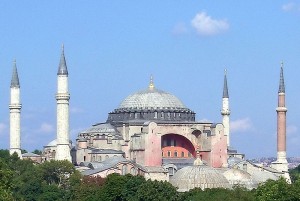Hagia Sofia

The great church of Hagia Sophia (Holy Wisdom) was one of the supreme architectural achievements of the eastern Roman empire. It was built on the site of an earlier church by the emperor Justinian in AD 537, close to the Great Palace of the Emperors in the heart of Constantinople. It is important to us first of all because of its architectural achievement. It departs from established Classical traditions by focusing the attention of the visitor upon its interior, rather than its exterior. Its architects also managed to combine the liturgical requirements of the eastern Roman church with a centrally planned interior comprising a breath-taking series of internal vaulted spaces capped by a magnificent dome that evoked heaven itself. It is also significant to us because of its very close association with the emperor Justinian, effectively helping to legitimize his self-proclaimed role as earthly representative of God on earth and guardian of the Orthodox faith. Paradoxically, following the sack of Constantinople by the Turks in 1452, Hagia Sophia was transformed into a mosque and the minarets were added, and became a model for mosques across the Islamic world.
Reading
Mainstone, R. J. 1988, Hagia Sophia. Architecture, Structure and Liturgy of Justinian’s Great Church. London: Thames & Hudson

Leave a Reply